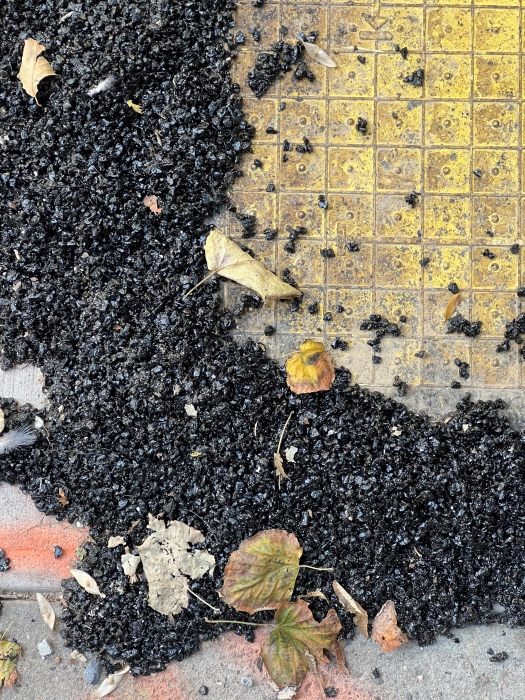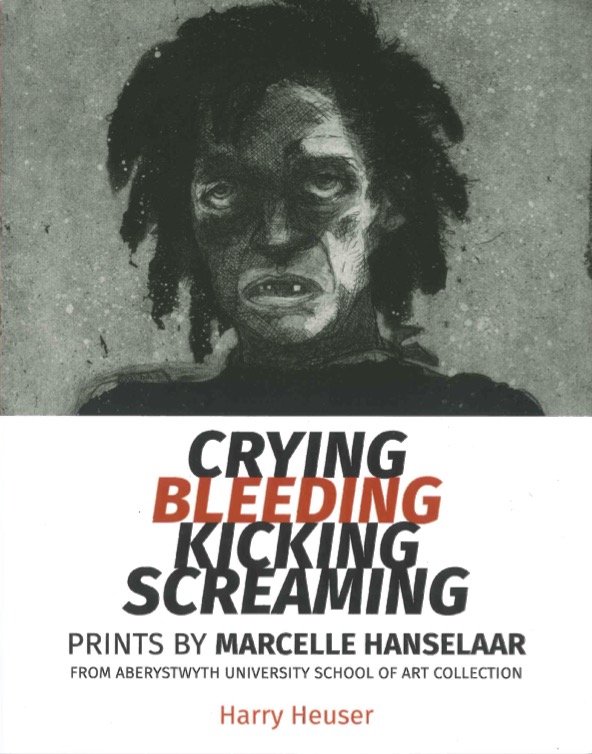Born and raised in Germany, educated in New York City (BA, MA, PhD) and living in Wales, Harry Heuser is a writer, educator and exhibition curator.
Current and recent projects
In my research, writing, curating and teaching, I explore relationships between the popular and the personal, the multiple and the singular, the durable and the ephemeral, as well as between form and medium. Given their hybridity and marginality as a form of drama and literature, radio plays have provided a particularly stimulating playground in which to explore those relationships as well as question assumptions that complicate our engagement with them.

One of my ongoing projects is, Asphalt Expressionism: Mobile Phone Photography of NYC Pavements. Next on view at Gallery Gwyn, Aberaeron (7 June – 2 Aug. 2024), the project yields large-scale digital prints of New York City’s scratched, streaked and splattered sidewalks, impressions of which were gathered during a monthlong return visit to the Big Apple in the autumn of 2022. One aim of my practice is to consider contemporary mobile phone photography, the most common mode of capturing the mundane and memorable alike, in the contexts of canonical art and its histories. In particular, it relates the visual culture of those stumbled-upon public spaces to the Western artworld of the 1950s and 1980s, of which New York City was widely held to be the capital.
Autobiographical and interactive, Asphalt Expressionism invites reflections on the relationships between life, art and the museum environment. The project builds on my exhibition Travelling Through: Landscapes/Landmarks/Legacies (previously on view at the School of Art Museum and Galleries in 2018-19), which, along with paintings, prints, posters, and ceramics from the School’s collection, featured personal photographs charting my relationship with New York City from the mid-1980s to the present day.
I will return to Gallery Gwyn with Retroactive Selfies in October 2024 as part of the group exhibition Inter_Change, for which I am serving as a mentor to emerging artists in Wales who will be exhibiting their work in the context of identity and diversity.

One of the final two exhibitions I staged at SoAM&G (School of Art Museum and Galleries, Aberystwyth) in 2023 is Crying, Bleeding, Kicking, Screaming: Prints by Marcelle Hanselaar from the School of Art Collection (22 May – 6 October; extended from 29 September) It was part of a series of annual curatorial projects undertaken with students of the undergraduate module Curating an Exhibition, which I created and was teaching from 2012 to 2023. The exhibition brought together a selection of etchings and aquatints from Hanselaar’s portfolios We’re all bleeding (2012) and The Crying Game (2015/17). Hanselaar joined me on 4 October for a gallery talk, and a catalogue was published in 2023 in conjunction with the exhibition. A follow-up project, now in the works, is a monograph on Hanselaar.







Of particular interest to me as a former Senior Lecturer in Art History is the relationship between art history and curating. My undergraduate exhibitions were drawn exclusively from the collections of the SoAM&G at Aberystwyth, providing opportunities for hands-on, primary research for students and staff, which I aimed to facilitate in my role of Director of Research at the School.
In February 2023, I delivered a webinar about the School of Art collections for Art Unlocked, an online talk series developed by Art UK in collaboration with Bloomberg Philanthropies. For the talk, I chose six representative objects from the collection, all of which have featured in exhibitions I staged at the School. Among them were works by painter-printmakers Stanley Anderson and Marcelle Hanselaar, photographer Angus McBean, and conceptual ceramicist Paul Scott.
As a collector of screen, stage, and radio related ephemera, which I exhibited at the School of Art Museum and Galleries in 2014-15, I am intrigued by ways in which mass-produced matter is invested with personal relevance, as well as by the motivations or reluctance of the collector to make a public display of a private passion. In January 2023, I contributed to a workshop on ephemera, where I presented “Making It Matter: Ephemerabilia, Queer Identity, and the Imperative of Being Out of Touch.”
My engagement with the intersections of stage, screen, broadcasting and the printed image and word—particularly the liminality of what I termed the ‘immaterial culture’ of radio—is firmly rooted in my queer experience and my sense of hybridity, dislocation and failure.
In a collaboration with playwright Lucy Gough, I organised a free event at the National Library of Wales. “Danger” 1924/2024: Commemorating the (Welsh) Origins of BBC Radio Drama marked the one-hundredth anniversary of Richard Hughes’ “Comedy of Danger” (1924), reputed to be the first play for radio commissioned by and presented on the BBC.
During the event on 22 February 2024, the short play, set in a Welsh coal mine and featuring the hymn tune “Aberystwyth,” was performed by students from Aberystwyth University. In an introductory talk titled “‘I’d expect anything of a country like Wales’: Richard Hughes and the Welshness of ‘Danger,'” I considered Richard Hughes’ contributions both to radio drama and to the cultures of Wales, given the play’s setting. The references to Wales eluded me when, in the late 1990s, conducting research for my dissertation on old-time radio as a graduate student in New York City, I experienced the play as a recording of a 1936 US production for network broadcasting, having never heard of Aberystwyth, let alone imagine that I would live there one day.
Staged in the Sound Archive housed at the National Library of Wales, the event featured a talk by Alison Hindell, Radio 4’s Commissioning Editor for Drama and Fiction.
Revisiting the subjects of PhD dissertation Etherized Victorians and my study Immaterial Culture: Literature, Drama and the American Radio Play, 1929-1954 from the perspective of an art historian, I contributed, without institutional support, “A Forefront in the Aftermath? Recorded Sound and the State of Audio Play on Post-‘Golden Age’ US Network Radio” to the anthology Tuning in to the Neo-Avant-Garde (Manchester University Press, 2021). The essay expands on my previous research of radio’s so-called “golden age” by considering the state and status of US American radio plays, and the CBS Radio Workshop (1956-57), at the beginning of the television era. The starting point was a paper I delivered in November 2018 at the Tuning in to the Neo-Avant-Garde conference at Ghent University.
My essay “‘There ain’t no sense to nothin”: Serial Storytelling, Radio Consciousness, and the Gothic of Audition” has been published in the anthology Audionarratology: Lessons from Radio Drama (Ohio State University Press, 2021). The chapter aims to explore the alienating—or gothic—experience of taking in and responding to serial fiction created for radio decades ago but accessed belatedly through modern technology.
Research is currently underway on a monograph on the painter-printmaker Harry Morley, to be co-authored with Robert Meyrick.
For further updates on my life and activities, academic or otherwise, visit my online journal broadcastellan.


